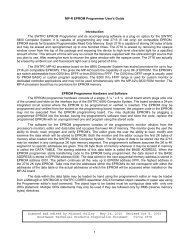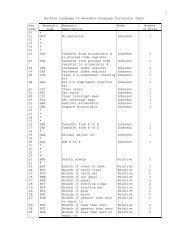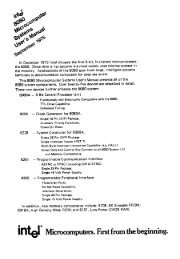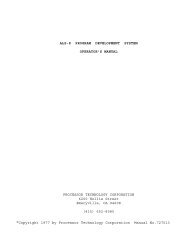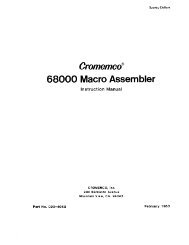The System Manual of SOL-20 - History of Computers
The System Manual of SOL-20 - History of Computers
The System Manual of SOL-20 - History of Computers
You also want an ePaper? Increase the reach of your titles
YUMPU automatically turns print PDFs into web optimized ePapers that Google loves.
PROCESSOR TECHNOLOGY CORPORATION<br />
Sol THEORY OF OPERATION<br />
SECTION VIII<br />
first U108 stage, it serves as a variable shunt. A low gate voltage<br />
on Q3 decreases the shunt resistance and the input to U108. In a<br />
like manner, a high voltage on C67 results in an increased input to<br />
U108. 03, Q4 and Q5 with their associated circuitry, therefore,<br />
serve as an automatic gain control (AGC) circuit which limits the input<br />
to the second U108 stage to approximately a positive 2 volt peak<br />
signal.<br />
<strong>The</strong> second stage <strong>of</strong> U108 is a comparator with hysteresis that<br />
performs the needed audio to digital conversion. Feedback resistor<br />
R147, in conjunction with R145, establishes the level on the positive<br />
input (pin 3) <strong>of</strong> U108. This level, be it positive or negative, is<br />
the threshold voltage, ±50 mv, which the negative input (pin 2) must<br />
exceed in order for the output <strong>of</strong> U108 to switch levels, positive to<br />
negative and the converse. Since the feedback loop is regenerative,<br />
U108 switches at its maximum rate, and U108 switches on each transition<br />
<strong>of</strong> the audio signal input. It is in this manner that U108 performs<br />
the audio to digital conversion.<br />
<strong>The</strong> digital output <strong>of</strong> U108 is inverted in one section <strong>of</strong> inverter<br />
U109 and applied to pin 9 <strong>of</strong> exclusive OR gate U99 which is<br />
connected as a buffer without inversion. If the output <strong>of</strong> U109 is<br />
low, the output on pin 10 <strong>of</strong> U99 is also low and the output on pin 4<br />
<strong>of</strong> another U99 exclusive OR gate is high. <strong>The</strong> voltage across C49<br />
under this condition is minimal. When the output <strong>of</strong> U109 goes high,<br />
C49 starts to charge through R118 until pin 9 <strong>of</strong> U99 crosses the<br />
threshold <strong>of</strong> that gate. At this point pin 10 <strong>of</strong> U99 goes high, and<br />
since the two inputs to the second exclusive-OR gate are both high,<br />
pin 4 <strong>of</strong> U99 goes low. C49 now discharges because pins 9 and 10 <strong>of</strong><br />
U99 are at the same level so that the circuit can repeat the operation<br />
on the next high to low transition at pin 4 <strong>of</strong> U109. R118, C49<br />
and U99 consequently serve as a transition detector that produces a<br />
pulse less than one microsecond long for each transition <strong>of</strong> the output<br />
on pin 4 <strong>of</strong> U109, regardless <strong>of</strong> the polarity <strong>of</strong> the transition.<br />
Transition pulses from U99 clock both D flip-flops in U113.<br />
A transition pulse clocks the top U113 at pin 3 which sets Q (pin 1)<br />
high and Q (pin 2) low to enable up binary counter U112 on pin 15.<br />
Pin 1 is applied to the T) input (pin 9) <strong>of</strong> the lower U113 and the<br />
circuit remains in this state until one <strong>of</strong> two things occurs: 1)<br />
a second transition pulse arrives before U112 reaches count 12 or<br />
2) U112 reaches count 12.<br />
If a second transition pulse arrives before count 12, the<br />
bottom U113 stage is set and presents a "1" to the D input (pin 9)<br />
<strong>of</strong> flip-flop U100. This is clocked by the !Q output on pin 2 <strong>of</strong> U113<br />
as a low to pin 12 <strong>of</strong> U100.<br />
If a transition pulse does not arrive before count 12, the<br />
bottom U113 stage outputs a "0" to input pin 9 <strong>of</strong> U100. On count<br />
12, the C and D outputs <strong>of</strong> U112 go high to reset U113 by way <strong>of</strong> U98<br />
at pin 4. As a result the U100 clock goes high, as does pin 12 <strong>of</strong><br />
VIII-37



